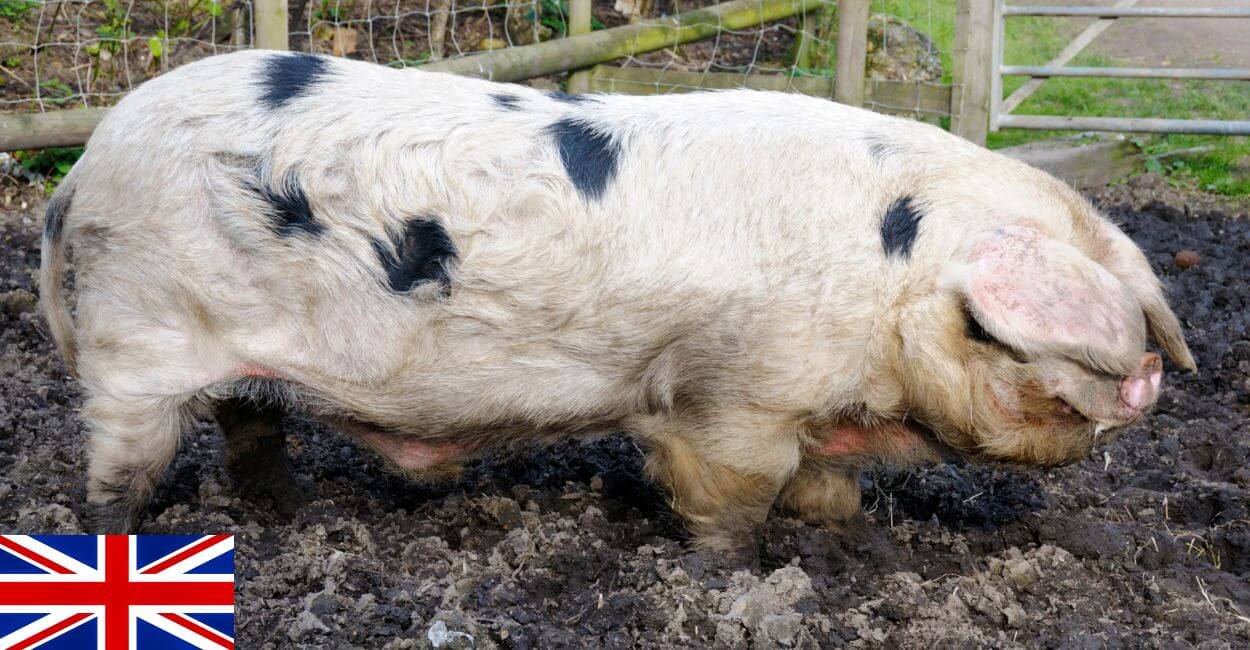
The Gloucestershire Old Spots is a rare pig breed currently listed as threatened by the Livestock Conservancy. Also known as the GOS or Orchard Pig, the origin of Gloucestershire Old Spots is not well-known, but it is believed to have been developed in the Vale of Berkeley in Gloucestershire, England.
The history of Gloucestershire Old Spots is said to have begun in the early 20th century when these pigs supposedly emerged from a crossbreeding between the original Gloucestershire pig (a large off-white pig with floppy ears and wattles) and the unimproved Berkshire (a sandy-colored pig with prick ears and black spots), according to the website of the Livestock Conservancy.
Their popularity declined after World War II as farmers and pig breeders focused on raising easier commercial pig breeds instead of pasture pig breeds like the Gloucestershire Old Spots.
Nevertheless, GOS have managed to survive to this day with the help of farmers who did not want this breed to become extinct and continued to raise a small number of these pigs.
Contents
Pig Characteristics
Physical Characteristics
Color
The Gloucestershire Old Spots has a white color with distinct black spots that give it the appearance of a Dalmatian pig. The black spots are a unique physical characteristic of this pig breed and can vary in size and shape. The spots are usually round or oval.
In order to register it, the presence of at least one spot on its body is required.
Hair
The hair of the Gloucestershire Old Spots is silky and straight.
Skin
The skin of this pig is pink and has no wrinkles or coarseness.
Size
Gloucestershire Old Spots are considered a large breed of pig.
Body
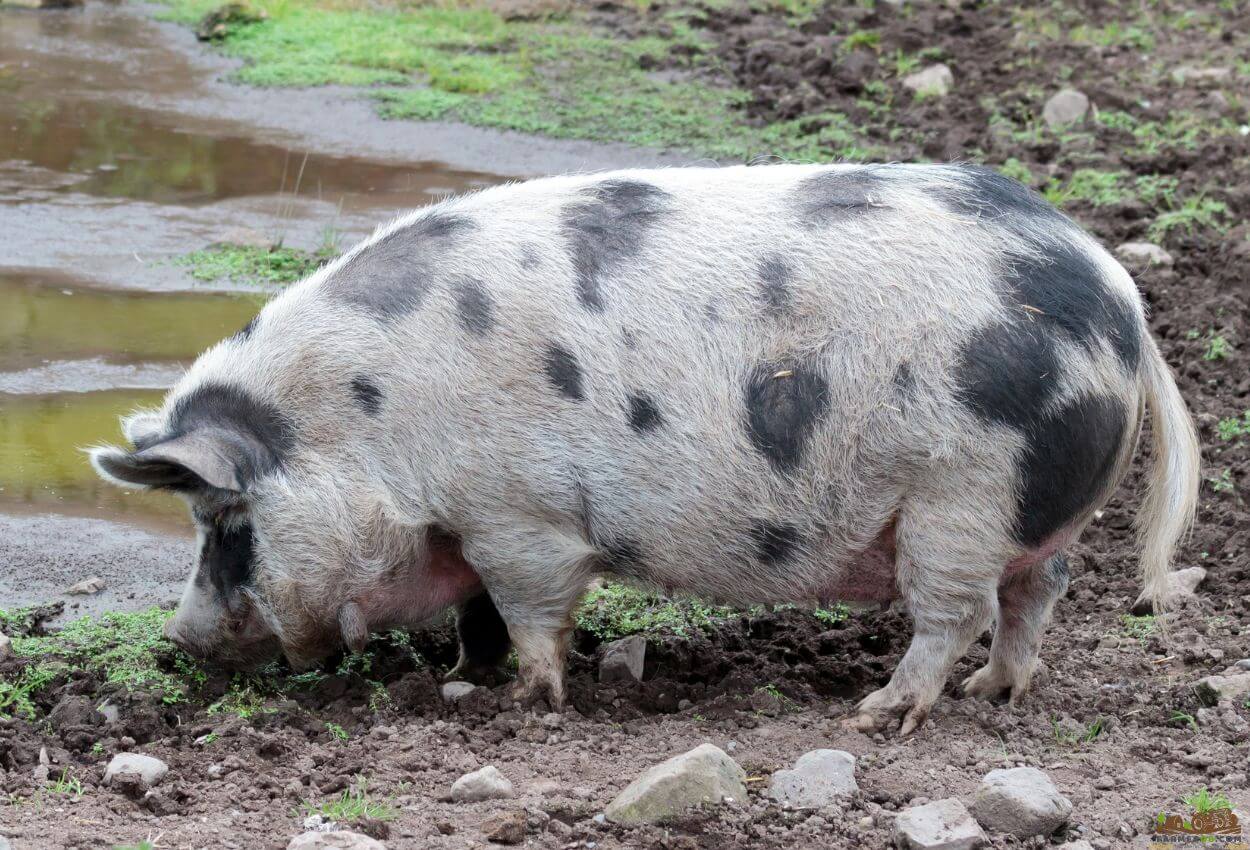
Its body is long, deep, and very robust. Also, the body has strong muscling, particularly in the ham area where it is noticeably developed. The back is broad, and the sides are well-rounded.
Head
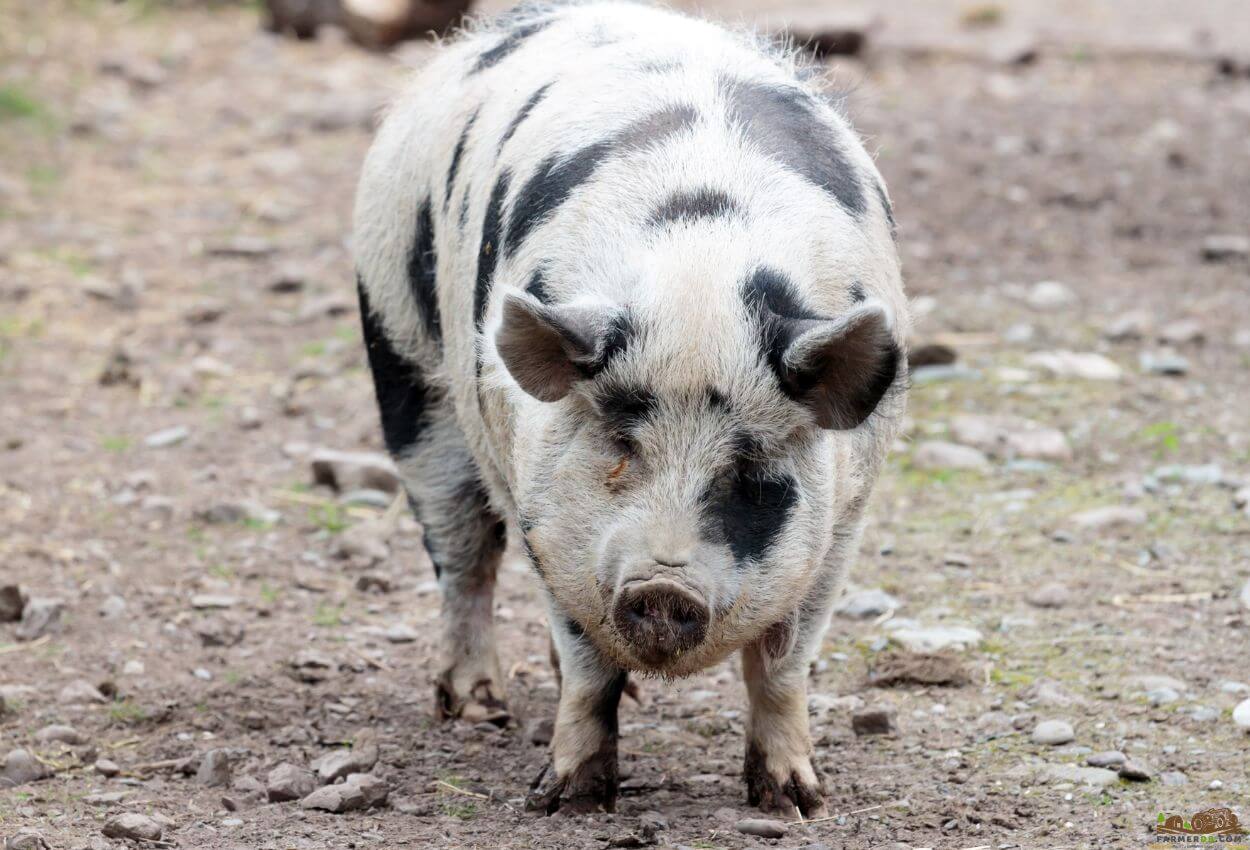
The head has a long length with a broad face and a slightly dished nose. Despite the dished nose, the snout is very well-defined.
Eyes and Ears
Their eyes are symmetrical, while the ears have very large flops that cover the eyes almost entirely, dropping above the nose. The ears are very well set apart.
Teeth
An adult Gloucestershire Old Spots has 44 teeth, while a Gloucestershire Old Spots piglet has only 28 teeth, which usually fall out around 12 months old.
The teeth of these pigs are covered in enamel, similar to human teeth, making them sturdy and strong. The pigs use these teeth to carefully chew their food. They need to chew their food because their digestive system cannot effectively process food that is not well chewed.
Legs
The legs of this pig are of medium length in proportion to its body, while also being very strong, sturdy, and straight. These robust legs allow the pig to move comfortably.
Shoulder
The shoulders of the Gloucestershire Old Spots are aligned with the back and the rest of the body, without any raised position.
Teats
The Gloucestershire Old Spots pig has a minimum of 14 teats that are well-positioned.
Lifespan
The lifespan of Gloucestershire Old Spots pigs averages around 10 years. While it may not be as long as other pig breeds like Mangalica, it is still considered a good lifespan and is similar to that of the Red Wattle pig.
Growth Rate
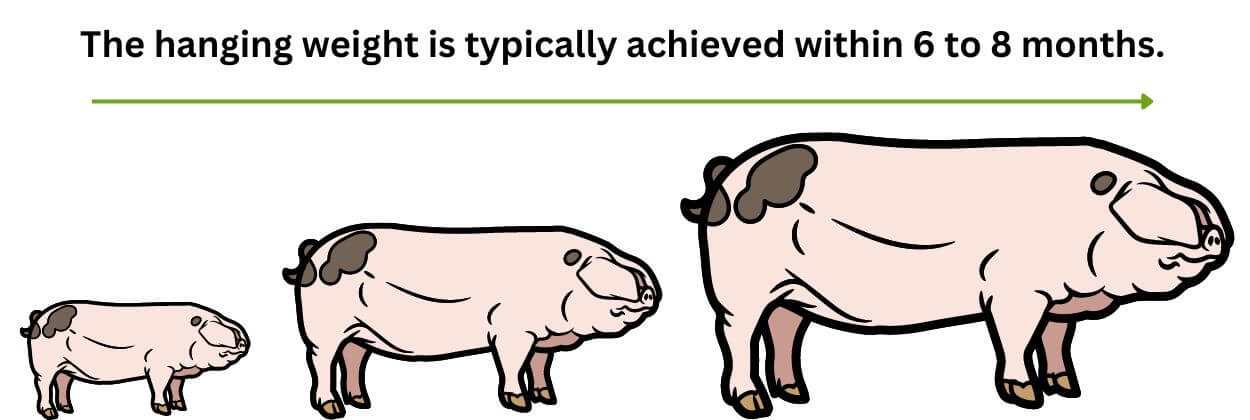
The Gloucestershire Old Spots growth rate is relatively moderate, as they can reach market weight in about 6 to 8 months. Their growth rate is not as fast as that of commercial pig breeds, but also not too long.
Things to know: This extended growth period allows them to develop a thick layer of back fat, which is superior to that of commercially raised pigs. The accumulation of back fat during this extended period enhances the tenderness and flavor of the pork.
Weight
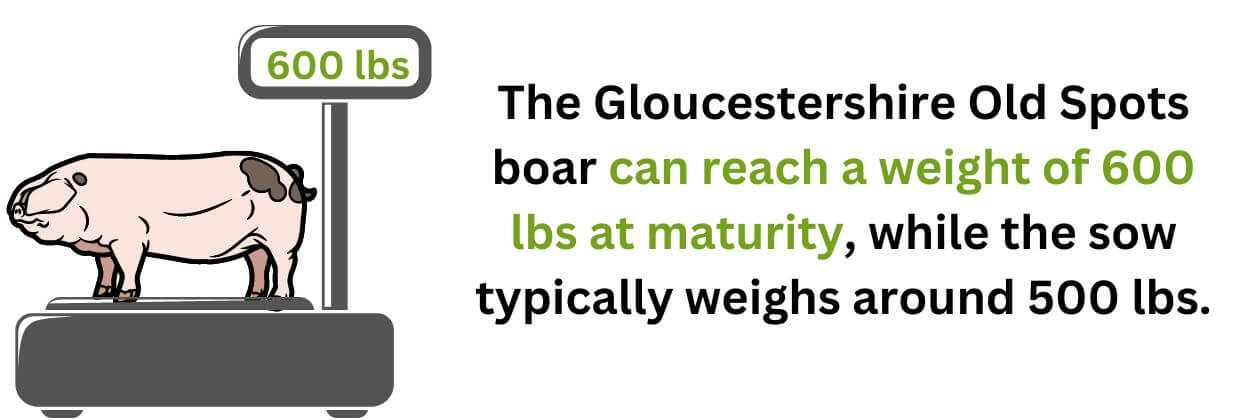
The Gloucestershire Old Spots boar can reach a weight of 600 lbs at maturity, while the sow typically weighs around 500 lbs.
However, the market weight or butcher weight of the Gloucestershire Old Spots preferred by many butchers is around 200 to 275 lbs. This hanging weight is usually achieved within the first 6 to 8 months, depending on genetics, diet, and environmental conditions.
Slaughter Time
Once the Gloucestershire Old Spots reach a weight of 200 to 275 lbs, they are ready for slaughter.
Things to know: When it comes to slaughtering such pigs, it is important to take your time. The carcasses are typically recommended to be hung on the bone for a period of three to four days after slaughter.
This practice helps to maintain the integrity of the carcass and prevent distortion. If a butcher attempts to work on the carcass before this period of time, it can lead to muscle distortion, resulting in poor butchery technique and an inferior final product.
Temperament and Behaviour
The Gloucestershire Old Spots is a remarkably calm and gentle pig breed, making it a good choice for the new ones that want to raise pigs or those seeking non-aggressive pig breeds.
These pigs enjoy socializing and receiving attention, including belly rubs and grooming when possible. They thrive in the company of other pigs and can quickly form bonds within their social groups.
Gloucestershire Old Spots are highly sociable with humans and other animals.
They are intelligent creatures and can quickly adapt to new environments. In fact, compared to other calm and docile pig breeds, Gloucestershire Old Spots pigs can even be trained to follow commands.
As pasture pigs, they are good foragers and enjoy their free surroundings. This is because they have been raised on pastures for generations. However, compared with other heritage pig breeds and foragers, GOS they have a more relaxed temperament. They do not become overexcited or curious; instead, they prefer to be lazy.
They also adore to dig and lay in mud to keep themselves cool.
Gloucestershire Old Spots sows possess great mothering abilities and strong maternal instincts. They can effectively care for their piglets with minimal intervention from the farmer.
Meat
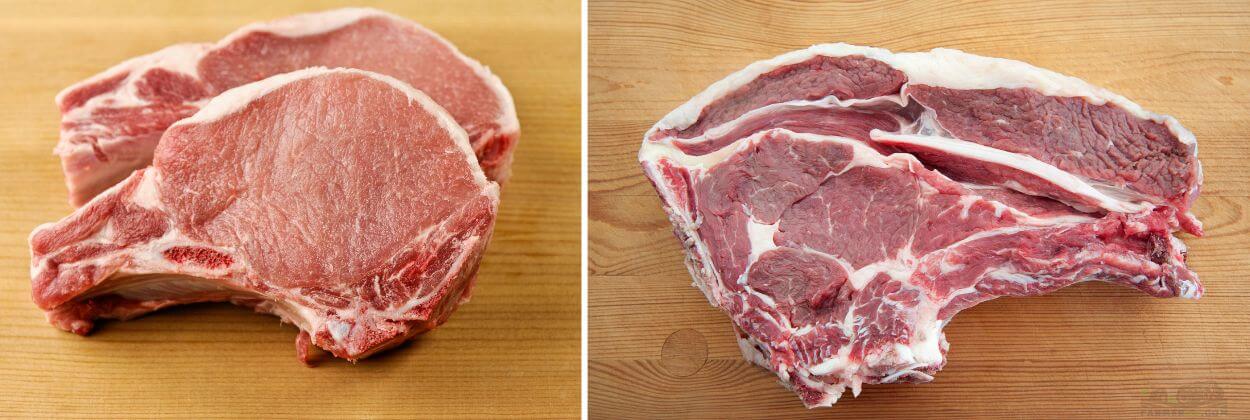
The Gloucestershire Old Spots meat is highly marbled, succulent, and tender, but its quality also depends on the pig’s diet and how it is raised.
Gloucestershire Old Spots pigs have a significant amount of fat, although not as much as Mangalica pigs. Still, they are not considered a lean meat breed either.
If these pigs are exclusively raised on open pastures and supplemented with grain, the quality of Gloucestershire Old Spots meat is superior compared to pigs raised only on grain.
Pigs of this breed that are fed only grain and not allowed to forage tend to accumulate more fat than lean meat, which can negatively impact the meat quality.
Nevertheless, when Gloucestershire Old Spots pigs are raised appropriately, they provide a meat with well-distributed fat throughout the muscle tissue.
The meat is typically tender and juicy, thanks to the well-distributed intramuscular fat. Their free-range lifestyle and regular exercise contribute to the proper ratio of lean muscle and fat.
This pig’s meat is often preferred for various pork products such as roasts, chops, sausages, bacon, and other dishes. Also, it is considered a delicacy in restaurants due to its juiciness, which is present in the fat content that helps retain moisture and succulence without drying out.
Another advantage is the high percentage of the total carcass weight that can be sold as usable meat after processing, which is approximately 71%. This means that 71% of the pig’s weight, excluding bones and fat, can be sold as meat.
For example, from a 240 lbs Gloucestershire Old Spots pig, you can sell approximately 170 lbs of meat.
However, what is the exact ratio?
If I was to use an industry-standard formula that considers factors such as back fat at the 1st and 10th rib, loin eye area, and hot carcass weight, the percentage of lean muscle in Gloucestershire Old Spots pig is approximately 46%.
Therefore, from the 170 lbs of meat obtained, around 78 lbs would consist of lean muscle tissue in the pig’s carcass.
As the meat of any other pasture pig breed, the meat is high in vitamin E, vitamin D, beta carotene, and good fatty acids that lower your cholesterol and triglycerides.
Growing Gloucestershire Old Spots Pig

Feeding
Gloucestershire Old Spots pigs are great foragers and grazers, and they will eat a lot if allowed to move freely on pasture. While on pasture, they can consume a variety of items such as forage, legumes, herbs, fruits, vegetables, and wholesome grains that are milled on-site.
If not present on pasture, you can occasionally offer them fruits, vegetables, or milk if available.
I would also recommend supplementing their diet with grain feed to ensure they grow healthily without any issues. Although they graze, they still require daily supplemental food to maintain a balanced diet with essential nutrients like proteins, carbohydrates, vitamins, fat content, and minerals.
Tip: Avoid overfeeding them to promote faster growth, as excessive feeding can result in more fat accumulation rather than lean muscle. Instead, control the amount of feed they receive and feed them twice a day (morning and evening).
Another piece of advice that I have for you is to feed them grain with a lower protein content (around 14% protein), rather than higher protein grain (18-22%) which may lead to forced growth. The grain with a lower protein content will not accelerate their growth.
What not to feed
Do not feed Gloucestershire Old Spots pigs processed or junk food, as these types of food typically contain excessive amounts of salt, sugar, and unhealthy fats. Consumption of such foods can impact their health in a negative way, potentially leading to weight gain and a decrease in meat quality.
It is also important to avoid feeding them moldy or spoiled food, as it can cause digestive issues
Water Intake
Daily fresh water is required to maintain the health of Gloucestershire Old Spot pigs. Clean water plays a vital role in the digestion, temperature regulation, and hydration of pigs. Therefore, it is crucial to provide them with a sufficient and easily accessible water source at all times.
Keep in mind that the amount of water they consume can vary based on factors such as their diet, weather conditions, and activity level. If they are more active or the weather is hotter, their water intake will likely increase. Make sure to replenish their water supply regularly.
Environment
When it comes to the environment, Gloucestershire Old Spots pigs are ideally raised on open pastures as they are natural pasture pigs, foragers, and grazers.
An outdoor open environment provides low-stress conditions allowing them to freely explore and discover their surroundings.
If you choose to raise them on an open pasture or in a forest, it is recommended to use an electric fence to ensure their safety from predators while keeping them in place. Within days, they will learn the perimeter and become accustomed to the fence, easily ignoring it after that.
Although Gloucestershire Old Spots pigs may be considered less active compared to other pasture pigs, they will still actively search for food in the pasture on their own.
Regarding the indoor environment, while it may not be the natural habitat for Gloucestershire Old Spots pigs, it is possible to raise them in barns for short periods of time. This can be necessary when outdoor space is limited, and there is a need to allow pastures time to recover due to not enough land for rotational management.
You can raise 8 to 10 Gloucestershire Old Spots pigs per acre.
Climate
Harsh cold weather is not an issue for these pigs, as they can handle colder temperatures quite well due to their straight and thick hair. Even though the adults do well in cold weather, they require special care when they are piglets.
If you live in a colder climate or plan to breed them during winter, it is important to know how to heat the nursery room and regulate the temperature for the piglets.
Regarding hotter weather they are capable of adapting and thriving in more sub-tropical environments. For them to grow healthy in a sunny area, it is important to provide appropriate arrangements. This includes having a mud hole, wallow, or shower for them to cool down, as well as enough shade to prevent sunburns.
Therefore, if you live in a hotter area, there is no need to worry. Gloucestershire Old Spots pigs are good at adapting, and they will naturally adjust their behavior. You will find them grazing during the cooler early morning and evening hours, while laying or sleeping in a mud hole or shade during the hotter parts of the day, simply relaxing.
Shelter
Gloucestershire Old Spots pigs need a suitable shelter where they can shelter during bad weather conditions, strong winds, or any other potential danger.
They do not require a specific type of shelter. Any type of pig shelter will work well for these pigs. The key is to ensure that their shelter is regularly cleaned and if using a barn, that it is well-ventilated.
Breeding
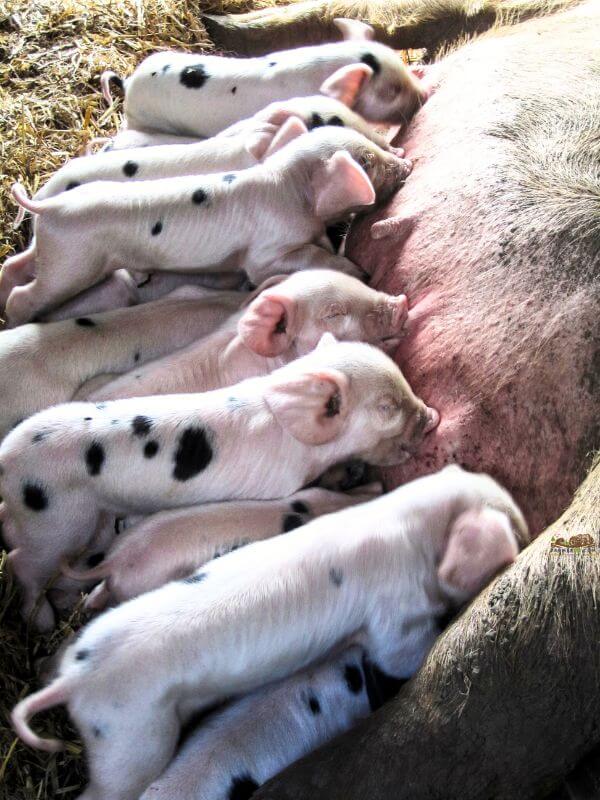
Breeding Gloucestershire Old Spots pigs is no different from breeding other pastured pigs. They can be bred all year round or during specific seasons, using either natural mating or artificial insemination.
The gestation period for these pigs is approximately 114 days (3 months, 3 weeks, and 3 days), and sows usually give birth to a litter of 8 to 10 piglets.
A Gloucestershire Old Spots sow is capable of having 2 to 3 litters a year, but this depends on your breeding goals. If a sow is caring for more than one litter per year, she must be well taken care of and provided with a nutritious diet.
The sow has good mothering skills and takes good care of her piglets. She cares for them and provides proper care until they are ready to be on open pastures.

When breeding Gloucestershire Old Spots pigs, it’s important to select the pigs that meet all the breed standards and have the desired traits of Gloucestershire Old Spots, as well as ensure they are in good health.
Health issues
Gloucestershire Old Spots pigs are generally hardy, but they can occasionally experience health issues. The most common health problems and diseases in Gloucestershire Old Spots include:
– Skin issues: Since they are raised in open pastures, they may be susceptible to skin conditions such as mange, lice, or other infections.
– Sunburns: Due to their white color and pink skin, Gloucestershire Old Spots are highly sensitive to sunlight. During warm seasons, they can get sunburned. Ensure they have access to sufficient shade or sheltered areas to protect their skin from harmful UV rays.
– Obesity: Overfeeding can lead to obesity in Gloucestershire Old Spots. Obesity can impact the ratio of fat to lean meat. Monitor their food intake to prevent excessive weight gain.
– Respiratory issues
Facts and Tips
Here are some additional tips and facts about Gloucestershire Old Spots pigs:
1. Gloucestershire Old Spots pigs are known for being very clean. They love to live in a fresh and clean environment. They also prefer to have separate spaces for different activities – they like to keep their bathroom area far away from where they eat, sleep, and rest. Even the piglets have the instinct to go to the bathroom in a separate area, away from their eating and sleeping location.
Therefore, it is important to clean their space regularly. Not only will they appreciate it, but it will also help reduce the risk of infections and other diseases.
2. Since they are a rare breed classified as threatened, you will find a lot of support from organizations and associations in raising and breeding them. This support helps in the preservation of this heritage breed. Therefore, you will have a great community that will be there for you throughout your journey of raising Gloucestershire Old Spots pigs.
3. If you live in a very rural area with no other animals or pigs, you can opt not to vaccinate them as they are generally healthy and hardy. However, if you have any other animals or there are any wild animals in the area, I would suggest vaccinating them for common pig diseases.
4. Gloucestershire Old Spot pigs are omnivores, so they eat various plants available on the pasture. During grazing time, they may consume other animals such as frogs or snakes if they come across them.
Why should you raise Gloucestershire Old Spot pigs?
Things to know: The Gloucestershire Old Spots pig is a maternal pig breed, which means that they have a ability to provide a large number of piglets.
Profitability
Can Gloucestershire Old Spot pigs be profitable and generate income? Yes, raising them can be financially beneficial through various methods.
Here’s how you can make money by raising Gloucestershire Old Spot pigs:
– Selling live pigs to other farmers or individuals: One way to generate income is by selling sow and boars to those interested in preserving this breed. A Gloucestershire Old Spots sow and boar can cost between each up to $400 to $450.
– Selling piglets: If you breed the pigs yourself and achieve a good litter size, which this breed is usually recognized for, you can sell piglets at around 8 weeks of age. A Gloucestershire Old Spots piglet typically costs between $180 to $200.
– If none of the above options fit your preferences, you can choose to butcher the pigs and sell the meat separately to individuals, meat production companies, or local restaurants. Meat prices can vary based on hanging weight or cuts. Half a pig can be priced between $600 to $800, while an entire pig can range from $1100 to $1500.
| Specification | Quantity | Price |
|---|---|---|
| Pork Loin Chops | 2.5 lbs | $55 |
| Pork Rack Chops | 2.5 lbs | $50-$60 |
| Porterhouse Chops | 3.5 lbs | $60 |
| Skinless Pork Belly | 2.5 lbs | $40 |
| Skinless Pork Butt | 8 lbs | $80 |
| Spare Ribs | 3 lbs | $50 |
| Pork Shank | 3.5 lbs | $50 |
Personal Use
If you choose to raise Gloucestershire Old Spot pigs as a homesteader, this breed will provide you with a good meat and a substantial amount of lard as they are known for producing high-quality carcasses and a generous quantity of meat.
Apart from being a source of meat and lard, some farmers enjoy their playful personalities and the fact that they follow them around the farm and take advantage of break time to enjoy the offered belly rubs.
Advantages and Disadvantages
Let’s see the advantages and disadvantages of raising Gloucestershire Old Spot pigs that should be considered when choosing to raise them on a homestead or small farm.
| Advantages | Disadvantages |
|---|---|
| They are very docile and gentle pigs. | They are a rare breed and can be hard to find for purchase. |
| They can adapt to various climates. | They are prone to obesity. |
| They are hardy animals. | They can get sunburn in summer and need shade and shelter. |
| They are excellent foragers for pasture-based farms. | The market demand is not as high as for mass-produced commercial pork. |
| They have a larger litter size. | |
| Sows have natural mother skills. | |
| They are very clean, which makes them less prone to infections and diseases. |
Tips for buying GOS
When buying Gloucestershire Old Spots, you should evaluate the pig’s health, breed authenticity, and registration. You should also assess the environment in which the pigs are raised to ensure it is clean and comfy.
If you plan to buy a sow and a boar for breeding purposes, it is important to gather information about their genetics and family lines.
All true and purebred Gloucestershire Old Spots belong to one of four color groups: Red, Black, Green, and Blue. These color groups do not represent their actual skin color but are part of a unique system developed by George Styles, a Gloucestershire Old Spots breeder, to show cyclic breeding. Each color group has a maximum of four female names, whereas only one exclusive male name is assigned to each group.
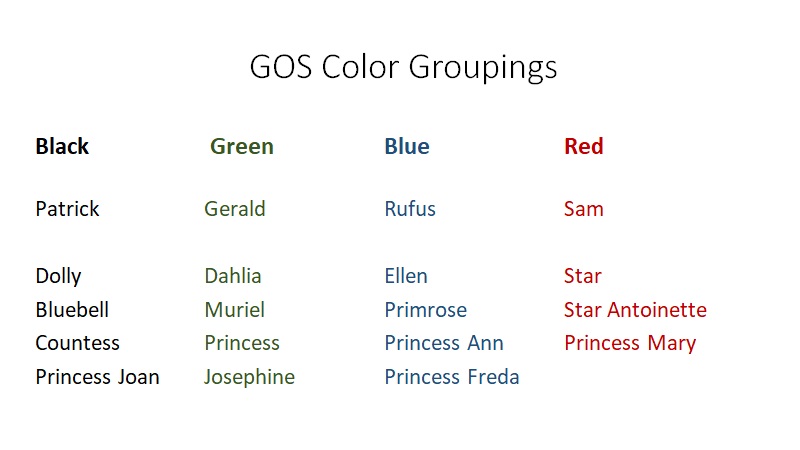
But breeders are not obliged to use this system. That is why it is recommended to purchase the sow and boar from different breeders to avoid them being closely related.

